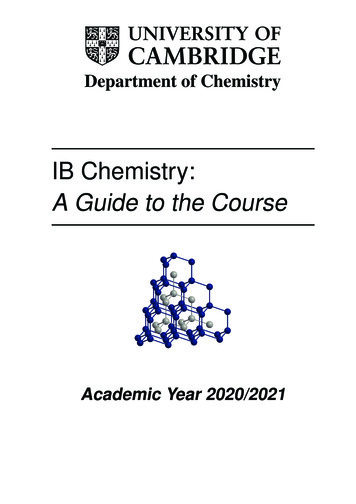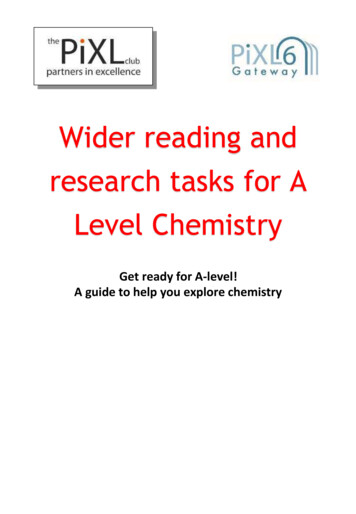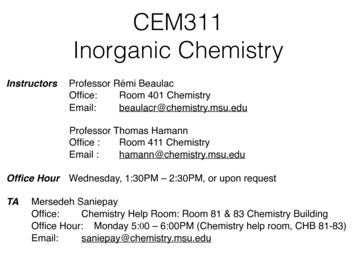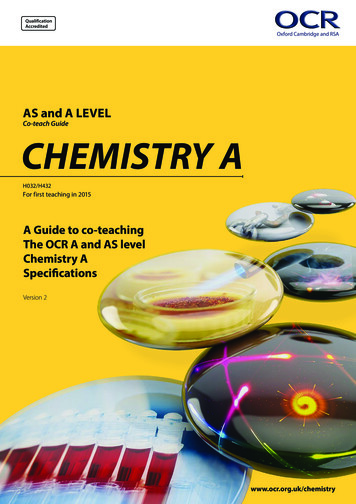
Transcription
Department of ChemistryIB Chemistry:A Guide to the CourseAcademic Year 2020/2021
The Department of Chemistry endeavours to develop an inclusive,supportive and intellectually stimulating environment for ourundergraduate community.Athena SWAN is an ongoing program to address theunderrepresentation of women in the sciences. The Silver Awardrecognises the progress that the Department has made in recentyears, and the actions that benefit not only our female students, butall our undergraduate chemists.Information about activities and profiles will appear inside the frontcover of your lecture handouts.
IB Chemistry 2020/21Chemistry A lectures are scheduled for 12:00 and those for Chemistry B for 09:00Lecture recordings will be released on Moodle at 09:00 according to the timetable /5EasterABWe JHK† KCAHFrSaMoSRB‡TuWeSRB/RJL‡†Note that the first lecture in theEaster Term is given on Wednesday‡Inorganic chemistry revisionlectures; both at 12:00
ContentsLecture timetableinside front cover1 Introduction12 Outline of the courses23 Lecture synopses for Course A34 Recommended books for Chemistry A55 Lecture synopses for Course B66 Recommended books for Chemistry B97 Practical work118 Plagiarism139 Examinations1410 Disclosure of examination marks1611 Chemistry teaching website1712 Chemistry Consultative Committee1713 Further details of the department1714 Library1815 Looking ahead: Chemistry in the third year and beyond181IntroductionThe second-year courses build on the topics studied in the first year and explore these chemicalideas and principles in more depth. A broad range of topics is covered and the connectionsbetween these different topics are emphasised, as is the way in which one idea grows fromanother and can be developed to aid our understanding of chemistry as a whole. The courseslay a firm foundation of chemical principles which inform both more advanced study of chemistryand also related areas such as Biochemistry, Physics, Molecular Biology, Materials Science andEarth Sciences.Two courses are offered in the second year: Chemistry A and Chemistry B; students may takeeither or both of them. Chemistry A focusses mainly on the theories which are used tounderstand and probe chemical bonding, structures and reactions. It starts out with a discussionof quantum mechanics which is the fundamental theory used by chemists to understand themicroscopic nature of matter and molecules. The course goes on to use these ideas to discusschemical bonding, the way in which microscopic properties influence those of bulk matter, andhow all of these ideas can be used together to understand the properties and chemistry of solidmaterials. The underlying theme which runs through the course is endeavouring to understandthe microscopic nature of molecules, matter and reactions.1
Chemistry B focusses mainly on how chemists find out about and rationalise the enormousrange of chemical structures and reactions that are known; a wide range is covered, from thefamiliar world of carbon-based chemistry, through the huge diversity of compounds andstructures that are the domain of inorganic chemistry, and finally to the important topic ofbiological chemistry, in which we look at the chemistry of life. Despite the huge range that thecourse will cover, we will find that we can begin to make sense of it all by using a relatively smallnumber of key concepts in chemical bonding and reactivity. As the discussion develops, thecentral role taken by electronic structure and the three-dimensional shape of moleculesbecomes apparent; it is these properties that influence their reactivity and other properties.If you are planning on continuing with chemistry in the third, and possibly fourth, year, the bestchoice is to take both Chemistry A and B in the second year. By doing this, you will have thebest coverage of chemistry, and be able to choose from the full range of specialist courses onoffer in the final years. A route is provided within Part II Chemistry for those who have only takenChemistry B in Part IB, but it is important to realise that by taking this route you will have a morerestricted range of options. If you have only taken Chemistry A it may be possible to continuewith Part II, but you will need to undertake some directed study over the preceding vacation.Within IB Natural Sciences there are many courses which complement the two chemistrycourses. Physics, Materials Science, and Mathematics are commonly taken alongsideChemistry A. Any of the biological courses with a more ‘molecular’ slant sit well with ChemistryB, and those with interests in Earth Sciences will find useful content in both Chemistry A and B.The individual lecture courses in Chemistry A and Chemistry B are outlined below, and acomplete timetable is given on the inside of the cover page.2Outline of the coursesChemistry A and Chemistry B are outlined below: follow the tables vertically down the page.The number of lectures in each course is given in the bracket. A complete timetable is given onthe reverse of the front cover.Chemistry AChemistry BMichaelmas TermMichaelmas TermIntroduction to quantum mechanics (13)Aromatic and enolate chemistry (6)Molecular spectroscopy (7)Conjugate addition and chirality (5)Introduction to stereochemistry (7)Symmetry and bonding I (3)Shape and organic reactivity (6)Lent TermLent TermSymmetry and bonding II (11)Structure, bonding and reactivity of transitionmetal complexes (17)Molecular energy levels andthermodynamics (13)Structure, bondingand the p-block elements (7)Easter TermEaster TermElectronic structure andproperties of solids (12)Introduction to chemical biology (11) These courses are interspersed with one another2
3Lecture synopses for Course AIntroduction to quantum mechanics: 13 lecturesProf. Stuart AlthorpeThe principles of Quantum Mechanics underlie all of chemistry at the molecular level, andprovide a foundation on which the subsequent courses in Chemistry A are built. This course willintroduce the fundamental ideas of quantum mechanics, and show how they may be applied tosome simple but important examples: the harmonic oscillator, the rigid rotor and the hydrogenatom.From there we shall move on to many-electron atoms and the consequences of electron spin,and finally show how the variation principle leads to an understanding of chemical bonding.Mathematically, all that is required is some fluency with Part IA Mathematics (course A). Thepractical course in the Michaelmas Term contains a set of computer-based exercises designedto illustrate the contents of this course.Molecular spectroscopy: 7 lecturesDr Steven LeeSpectroscopy provides us with some of the best evidence for the quantization of energy. Thiscourse is integrated with the Quantum Mechanics course and illustrates how the key ideas maybe used to understand the appearance of spectra and allow us to determine fundamentalmolecular parameters. The course also provides the background for the laboratory sessionswhere you will be able to put the theory into practice.We shall start with the rotational spectra of diatomic molecules and its applications frommicrowave spectroscopy in the labs, which allows us to determine bond lengths in simplemolecules, to radio astronomy which allows us to determine the composition of heavenly bodies.We shall then examine vibrational spectroscopy using both the harmonic oscillator and Morseoscillator as models. Finally, we shall touch on the electronic spectroscopy of atoms and simplemolecules.Symmetry and bonding: 14 lecturesProf. Rod JonesHumans seem to have an innate ability to recognise and appreciate the symmetry of objects,and chemists seem to be especially fascinated by molecules or other structures which displayhigh or unusual symmetry. In this course we will show how Group Theory provides a formalframework for describing the symmetry of molecules and how this theory can be used as apowerful tool for predicting the properties and behaviour of molecules. In particular we will lookat how symmetry helps us to construct molecular orbital (MO) diagrams and then how these canbe used to understand key properties such as shape or stability.We will also see how symmetry helps us to understand the vibrations of molecules via a normalmode analysis. Finally, we will look at how we can actually calculate the energies and form ofthe MOs in simple molecules using the Hückel approach. The application of symmetry to suchcalculations results in considerable simplification.This course will take a relatively informal approach to Group Theory with the emphasis being ondeveloping a practical set of tools which can be applied with ease.3
Introducing Group Theory Symmetry elements and symmetry operations. Point groups.Character tables. Representations. Direct products.Applications Vanishing integrals. Symmetry orbitals and molecular orbitals. Transition metalcomplexes. Hückel MO calculations. Normal mode analysis and vibrational spectroscopy.Dipole moments and chirality. Infinite groups and the symmetry of electronic states.Molecular energy levels and thermodynamics: 13 lecturesProf. Stuart ClarkeQuantum mechanics provides us with a detailed description of the energy levels of single atomsand molecules, but when we are doing chemistry we deal not with one molecule at a time butvast numbers. The question is, then, how are the properties of bulk matter related to the energylevels of the molecules of which it is composed? The methods of statistical thermodynamics,which are introduced in this course, make this connection. In particular, we will see how thethermodynamic properties of matter (internal energy, entropy, Gibbs energy etc.) can becalculated from a knowledge of the molecular energy levels. As you will have seen in the earliercourses, these energy levels can be predicted by quantum mechanics and determinedexperimentally from spectroscopy. We will also investigate the Boltzmann distribution which isused to understand many molecular phenomena.The course closes with a number of applications of the ideas developed in the earlier part. Wewill look at how it is possible to understand the temperature variation of heat capacities, and howit is possible to predict the values of equilibrium constants simply from spectroscopic data.Statistical thermodynamics can also be used to predict the values of reaction rate constantsusing transition state theory. We will look at how this is developed and the interpretation of theparameters involved.Topics Review of thermodynamic ideas: the Second Law, internal energy, the Gibbs and Helmholtzfunctions. Microstates and macrostates: the canonical distribution function, the partitionfunction and thermodynamics quantities.Evaluation of the partition function: translation, rotation and vibration.Internal energy and heat capacities; temperature variation. Calculation of absolute entropies.Chemical equilibrium and the prediction of equilibrium constants.Transition state theory: concept of a potential energy surface and the transition state;formulation in terms of partition functions; comparison with collision theory. Thermodynamicformulation.The Boltzmann distribution; applications in spectroscopy. Density of states.Electronic structure and properties of solids: 12 lecturesDr James KeelerThe objective of this course is to introduce the concepts of structure and bonding that arerequired to explain the behaviour of electrons in solids. The course is designed in such as waythat it builds upon the material presented in all of the preceding courses in Chemistry A. At theheart of the course lie two contrasting models for the behaviour of electrons in solids – the freeelectron and the LCAO models.Free electron theory is used as a starting point because it is simple and it permits theintroduction of essential concepts such as wavevectors, travelling waves and the Fermi surface.However, this theory does not take account of the presence of atoms and orbitals and offers nostructural predictions. LCAO theory is used to show how atomic orbitals may be used as a basisfor constructing wavefunctions appropriate for solids. This theory is used to explain the bondingand energy bands in a wide variety of solids.4
The last part of the course focuses on semi-conductors and doped semi-conductors which areexceptionally important as they are used to create the basic building blocks of all modernelectronic devices.Topics Introduction to the description of crystalline materials: lattices; unit cells; space filling.The free-electron theory of solids: plane waves; the reciprocal lattice; wavevectors.The Fermi–Dirac distribution: the Fermi level; the Fermi energy; the Fermi surface.Electrical conductivity and other physical properties.Tight-binding model for solids: bands; band gaps; band structure.Semiconductors: doping; electrical properties; spectroscopic properties.Electronic devices: the p-n junction; transistors.4Recommended books for Chemistry AThese recommended books should be in your College Library. They can also be consulted inthe Departmental Library, and some are available on short loans. The designations in brackets[. . . ] are the class marks used to identify the books in the Chemistry Department Library, andyou should find these texts shelved separately as the Blue Book collection in Unit 17, on theright hand side as you enter the library.Quantum mechanicsGreen N.J.B. Quantum Mechanics 1: Foundations, Oxford Chemistry Primers, 1997. [QC174.12.G74]For reference: McQuarrie, D.A, and Simon, J.D, Physical Chemistry: A Molecular Approach, UniversityScience Books, 1997. [QD453.M37]For reference: Atkins P.W. & Friedman R.S. Molecular Quantum Mechanics, any edition, OUP.[QD462.A85]Steiner E. The Chemistry Maths Book, OUP, 1996. [QA37.3.S74]Molecular spectroscopyBanwell, C. and McCash, E., Fundamentals of Molecular Spectroscopy, 4th edition, McGraw Hill[QD96.M65.B36]For reference: McQuarrie, D.A, and Simon, J.D, Physical Chemistry: A Molecular Approach, UniversityScience Books, 1997. [QD453.M37]Symmetry and bondingVincent A. Molecular Symmetry and Group Theory, 2nd edition, Wiley, 2001. [QD461.V56]For reference: Cotton F.A. Chemical Applications of Group Theory, Wiley, 3rd Edn, 1990. [QD461.C68]For reference: McQuarrie, D.A, and Simon, J.D, Physical Chemistry: A Molecular Approach, UniversityScience Books, 1997. [QD453.M37]Molecular energy levels and thermodynamicsMaczek A.O.S Statistical Thermodynamics (Oxford Chemistry Primers 58), OUP 1998. [QD504.M33]2nd Edn. (2017) available.Gasser R.P.H. and Richards W. G. An Introduction to Statistical Thermodynamics, World Scientific,1995. [QC311.5.G37]5
Electronic structure and properties of solidsSmart, L. and Moore, E., Solid State Chemistry, 4th Edn, Chapman and Hall, 2012 [QD478.S63]West, A.R., Basic Solid State Chemistry, Wiley, 2nd Edn,, 1999 [QD478.W47]Cox P.A. The Electronic Structure and Chemistry of Solids, Oxford Science Publication, 1992.[QD478.C69]For reference: Singleton J., Band Theory and Electronic Properties of Solids, OUP 2001.[QC176.8.E4.S56]For reference: Elliott S. R. Physics and Chemistry of Solids, Wiley 1998. [QC176.5.E45]5Lecture synopses for Course BAromatic and enolate chemistry: 6 lecturesDr Stephanie SmithThis course is divided into two sections. The first looks at the structure and reactivity of thebenzene ring and explores the attack of electrophiles as the key reaction. In the second part welook at the formation and reactions of enols and enolates – these are nucleophilic species thatallow the synthetic chemist to construct a wide range of new bonds adjacent to the carbonylgroup.Topics Electrophilic aromatic substitutionAromaticity and aromatic compoundsElectrophilic aromatic substitutionReactions on substituted benzene derivativesSubstituent effects and multi-step reactionsEnols and enloatesCarbonyl-enol tautomerismAcid and base catalysed enolisationElectrophilic addition to enols and enolatesStable enolate synthetic equivalentsAlkylation issues and solutionsAlternative enolate functionalitiesNucleophilic attack on π systems: 5 lecturesDr Anthony CoyneThe conjugation of alkenes with electron-withdrawing groups makes them electrophilic andsusceptible to attack by nucleophiles. Conjugate addition, an important type of reaction involvingnucleophilic addition to the remote end of an alkene conjugated with an electron–withdrawinggroup, is discussed in detail. If the electron-withdrawing group in question is a carbonyl, thenucleophile can react either at the alkene (conjugate addition) or at the carbonyl (direct addition).Factors influencing the selectivity between these two modes of addition (the regioselectivity ofnucleophilic addition) are examined. Both direct addition and conjugate addition can createchiral carbon centres (carbon centres with four different substituents attached).A basic introduction to chirality is given, with a focus upon compounds containing one chiralcarbon centre. The Cahn–Ingold–Prelog system for labelling the configuration of chiral carboncentres and alkene geometries is described.6
Nucleophilic substitution at conjugated alkenes bearing a leaving group (conjugate substitution)is discussed. A related type of reaction involving nucleophilic substitution on aromatic rings(nucleophilic aromatic substitution) is examined.Topics Conjugate addition with α, β-unsaturated carbonyls.Direct addition versus conjugate addition.Conjugate addition with other electron-deficient alkenes.Introduction to chirality.Labelling chiral centres: the Cahn–Ingold–Prelog rules.Conjugate substitution.Nucleophilic aromatic substitution.Introduction to stereochemistry: 7 lecturesDr Peter WothersMolecular shape and reactivity is the foundation of organic chemistry. We need to be able tounderstand the critical, and often subtle, interactions between the shape of a molecule and itsreactions. In three dimensions, molecules have more flexible shapes than two-dimensionalstructures with rigid π systems. In this course we will look at the different conformations thatmolecules can adopt and how stereochemistry plays an important role in determining reactivity.Topics Introduction to Chirality.Stereochemistry with two or more chiral centres.Resolution of enantiomers by forming diastereoisomers.Elimination reactions.Conformational analysis of chains and rings.Cyclisation reactions.Shape and organic reactivity: 6 lecturesProf. Jonathan GoodmanThe final part of the course will combine the concepts of two- and three-dimensional shape,stereochemistry and NMR and apply these to the analysis a variety of reactions. These ideascan then be applied to some unfamiliar systems to work out how they might react.Topics Alkynes and alkenes.Bases and nucleophiles.Kinetic and thermodynamic control.Imines, oximes, and hydrazones.Beckmann rearrangement.Acetals and aldols.Stereoselective reactions on chiral molecules.7
Structure, bonding and reactivity of transition metal complexes: 17 lecturesDr Sally Boss and Dr Paul BarkerThis eighteen-lecture course will introduce students to the rich and varied chemistry of transitionmetal complexes. The periodic properties of the metals and the types of molecule which metalswill coordinate to (the ligands) will be described. The bonding in the resulting metal-ligandcomplexes will be modelled using both Molecular Orbital Theory and Crystal Field Theory whichdiffer in their sophistication but share the same common symmetry arguments.The course will focus on the on the role of d-orbitals and d-electrons in transition metalchemistry and the physical and spectroscopic consequences that result from the d orbitalslosing their degeneracy on forming complexes with ligands. These include preferred geometries,oxidation states, high spin and low spin complexes and the magnetic and spectroscopicproperties of complexed transition metal ions.A consideration of ionic vs covalent bonding in transition metal complexes will be presented.Complexes which offer more covalency influence the chemical nature of the attached ligandsmore and it is these metal complexes which tend to be active catalytically. The key reactiontypes for more covalent metal complexes will be discussed in detail and their catalytic reactivitywill be explained.Topics The common structural geometries and stereochemistries of 1st-row transition metalcomplexesBonding models for transition metal compounds – Molecular Orbital Theory and Crystal FieldTheoryThermodynamic and electronic properties of transition metal chemistry – predicting structure,chemical behaviour and rationalising experimental results using bonding theoriesThe spectrum of ionic-covalent bonding in transition metal complexes and comparison of 3d,4d and 5d metalsKey reaction types of transition metal complexesTransition metal complexes as catalystsStructure, bonding and the p-block elements: 7 LecturesDr Robert LessThis course describes the synthesis, structures and bonding for p-block species such as theborazines, phosphazenes and thiazenes (B/N, P/N and S/N systems). Emphasis is placed onsynthetic methodologies, chemical reactivity and understanding how the main group elementsbond in the resulting compounds. A range of arguments have been proposed to rationalize thestructure and bonding principles underpinning these systems. Whilst pπ–pπ bonding inborazines is generally accepted, the bonding in phosphazenes has proved more contentiousand it is only recently that covalent bonding models have given way to a combination of moreionic perspectives and negative hyperconjugation. These ideas will be discussed and alsoapplied to sulfur-containing systems. Methods for characterising main group systems will beexplored. Students will be expected to extend structure, bonding and analytical concepts torelated systems, such as boroxane and siloxane (B/O, Si/O) derivatives.Topics There are many thousands of inorganic compounds composed primarily of p-block elements.Rather than survey all of them, selected N-containing system are focused on in order toexemplify concepts in synthesis, structure and reactivity: Borazanes and borazines; adductformation; the importance of pπ–pπ bonding in inorganics; substitution by addition eliminationreactions; comparisons with organic aromatics. Phosphazanes and phosphazenes; ionicapproaches to bonding; reactivity and substitution patterns. The thiazenes; stabilization ofweak S/N bonds; insertion reactions. Characterisation of main group inorganic systems; X-raydiffraction and multinuclear NMR spectroscopy.8
Introduction to chemical biology: 11 lecturesProf. Chris HunterThis course introduces the chemistry of biopolymers, exploring their structure, function andchemistry. The basic chemical concepts that govern non-covalent interactions will be illustratedby reference to the three-dimensional structures of the two most important classes ofbiomolecules, nucleic acids and proteins. Intermolecular interactions of organic molecules withDNA and proteins will be discussed along with the principles of drug design.Basic physical organic chemical concepts such as general acid and general base catalysis,transition state theory, free energy profiles, isotope effects etc. will be illustrated by reference toenzyme chemistry. The chemical mechanisms of proteases and other enzymes will bediscussed along with the principles of enzyme inhibition and its role in medicine.This course looks forward to Part II and Part III courses when some of the most exciting recentadvances in biological chemistry and chemical biology will be discussed. The approachthroughout the course will be based on structure and mechanism – we will not assume anyprevious biochemical knowledge.1–6 Non-covalent interactions: van der Waals forces, electrostatics, hydrogen bonding, aromaticinteractions, functional group properties, desolvation, hydrophobic effect, entropic effects,cooperativity.Nucleic acid structure: chemistry of heterocycles, sugars, phosphate esters, the double helix.Protein structure: chemistry of amino acids, peptides, secondary, tertiary and quaternarystructures.Interactions with small molecules and drug design.7–11 Thermodynamic and kinetic concepts relevant to biological chemistry including transition statetheory, kinetic isotope effects, free energy diagrams. General acid catalysis, general basecatalysis, electrophilic catalysis by metal ions, nucleophilic catalysis.The mechanisms of serine proteases, metalloproteases and other types of proteases.Enzyme inhibition and its role in medicinal chemistry.6Recommended books for Chemistry BThese recommended books should be in your College Library. They can also be consulted inthe Departmental Library, and some are available on short-term loan. The designations inbrackets [. . . ] are the class marks used to identify the books in the Chemistry DepartmentLibrary, and you should find these texts shelved separately as the Blue Book collection in Unit17, on the right hand side as you enter the library.Organic chemistryGeneral organic chemistryThere are a variety of good texts which all cover the first term’s material:Clayden J., Greeves N., Warren S. and Wothers P. Organic Chemistry, OUP, 2001.[QD251.O74]Clayden J., Greeves N. and Warren S. Organic Chemistry, 2nd Edn, OUP 2012. (Either edition isacceptable) [QD251.O74]Carey F. A. and Sundberg R. J., Advanced Organic Chemistry, 5th Edn, Springer 2007. [QD251.C37]Sainsbury M., Aromatic Chemistry, Oxford Chemistry Primer No. 4, OUP. [QD331.S25]McMurry J., Organic Chemistry, 9th Edn, Brooks/Cole 2016.[QD251.M36]Vollhardt K. P. C. and Schore N. E., Organic Chemistry, 7th Edn, Freeman 2018. [QD251.V65]Smith, M. B. and March, J. Advanced Organic Chemistry: Reactions, Mechanisms, and Structure, 7thEdn, Wiley, 2018. [QD251.M37]9
Structure determinationWilliams D. H. & Fleming I. Spectroscopic Methods in Organic Chemistry McGraw Hill 6th edition,2007. [QD272.S6.W55]Organic Structure Analysis, 2nd Edition Phillip Crews, Jaime Rodriguez and Marcel Jaspars. OxfordUniversity Press, 2010. [QD272.S6.C74]General inorganic chemistryCotton, F. A., Wilkinson, G., Murillo, C. A. and Bochmann , M., Advanced Inorganic Chemistry 6th Ed.,Wiley (1999). [QD151.C68]Shriver and Atkins Inorganic Chemistry, latest editions. [QD151.S57]Greenwood N. N. Earnshaw, A. Chemistry of the Elements, 2nd Edition. [QD466.G74]Douglas, B., McDaniel, D. and Alexander, J., Concepts and Models of Inorganic Chemistry, 3rd Edition.Wiley. [QD475.D68]Co-ordination chemistryM.J. Winter d–Block Chemistry, Oxford Chemistry Primer 27, OUP. [QD172.T6.W56] 2nd Edn, (2015)available.J. McCleverty Chemistry of the First-Row Transition Metals, Oxford Chemistry Primer 71, OUP.[QD172.T6.M33]J. Keeler & P. Wothers Chemical Structure and Reactivity (Chapter. 15) 2nd Ed. [QD471.K44]Organometallic chemistrySpessard, G.O. and Miessler, G.L., Organometallic Chemistry, Prentice Hall (1996). [QD411.S64]Elschenbroich, C., Organometallics, Wiley-VCH 3nd Ed. (2006). [QD411.E47]Bochmann M. Organometallics Volumes 1 and 2, OUP Primers (1994). [QD411.8.T73.B63]Crabtree R.H. The Organometallic Chemistry of the Transition Metals. 6th Ed. 2014.[QD411.8.T73.C73] 7th Edn. (2019) on order.Structure, Bonding and the p-Block ElementsF.A. Cotton, G. Wilkinson, C.A. Murillo & M. Bochmann, Advanced Inorganic Chemistry, John Wiley &Sons, 6th Ed, 1999. [QD151.C68]C.E. Housecroft & A.G. Sharpe Inorganic Chemistry, Prentice Hall, 4th Ed. 2012. [QD151.H68]N.N. Greenwood & A. Earnshaw Chemistry of the Elements, Pergamon Press, 2nd Ed. 1997.[QD466.G74]J.E. Huheey Inorganic Chemistry, Prentice Hall, 4th Ed 1997.[QD151.H84]N.C. Norman, Periodicity in the s– and p–Block Elements, Oxford Primer, 2nd Ed. 1997. [QD466.N67]T. Chivers & I. Manners Inorganic Rings and Polymers of the p-Block Elements, RSC publications, 1stEd. 2009. [QD196.C45]Introduction to chemical biologyA. R. Fersht, Structure and Mechanism in Protein Science: A Guide to Enzyme Catalysis and ProteinFolding, 3rd edition, W. H. Freeman, 1998. [QD431.25.S85]C. M. Dobson, J. A. Gerard & A.J. Pratt, Foundations of Chemical Biology, Oxford Chemistry Primers,OUP, 2001. [QD415.D63]E.V.Anslyn & D.A. Doughterty, Modern Physical Organic Chemistry, University Science Books, 2006.[QD476.A57]10
7Practical workThe current social distancing rules have implications for the occupancy levels of our teachinglabs, such that we will be making use of the large Part IA lab for the Chemistry B practical courseThese changes from our normal pattern of Part IB lab work are relatively modest and we do notbelieve that they will detract from your experience of the course.Further details on the operation of the lab classes will be provided in the laboratorymanuals for CHEMISTRY A and CHEMISTRY B courses. These can be collected from theBMS lecture theatre on MONDAY 5 OCTOBERThe practical work in chemistry fulfils two important ro
The individual lecture courses in Chemistry A and Chemistry B are outlined below, and a complete timetable is given on the inside of the cover page. 2 Outline of the courses Chemistry A and Chemistry B are outlined below: follow the tables vertically down the page. The number of lectures in each course is given in the bracket.










